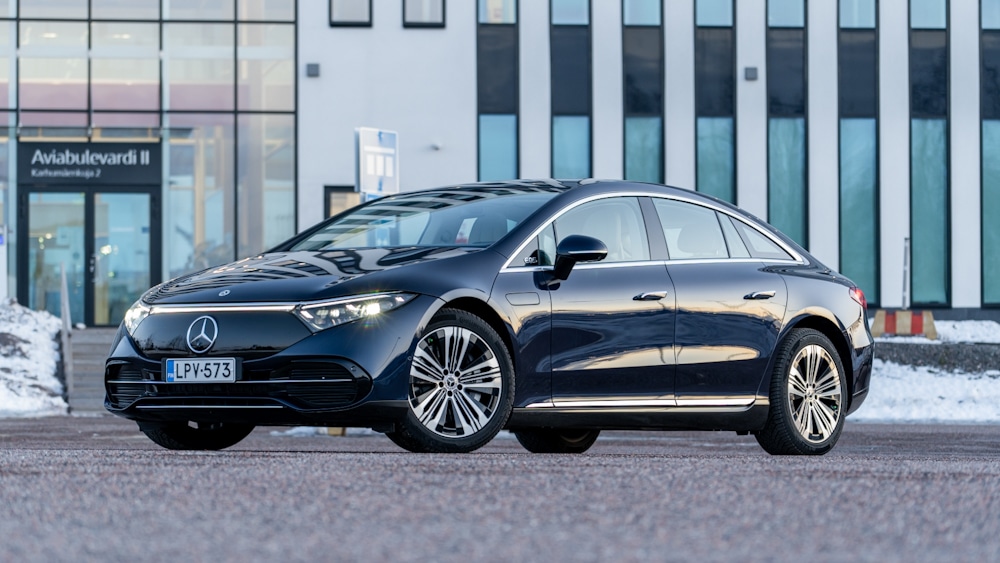When planning a spring ski trip north from Helsinki, the alternatives were car, plane and some form of public transport. The idea of driving a fully electric car to test the journey as quickly as possible, but above all effortlessly with normal physiological stopping needs, quickly springs to mind.

For the author, the trip to the north was the first of its kind, although several full-electric models have already covered several hundred thousand kilometres. So it was nice to get a concrete idea of how easy it would be to drive an electric car in winter in the north of Finland, even with the current charging network.
It also seemed an attractive idea to make the journey with just one charging break in the light spring frost. With the need to fit half a week’s skiing and downhill skiing equipment for four adults without compromising on comfort, the potential range of car models capable of doing this was admittedly becoming limited.
The car would have to go at least 450 kilometres in sub-zero temperatures without charging to make the one-charging tactic work.
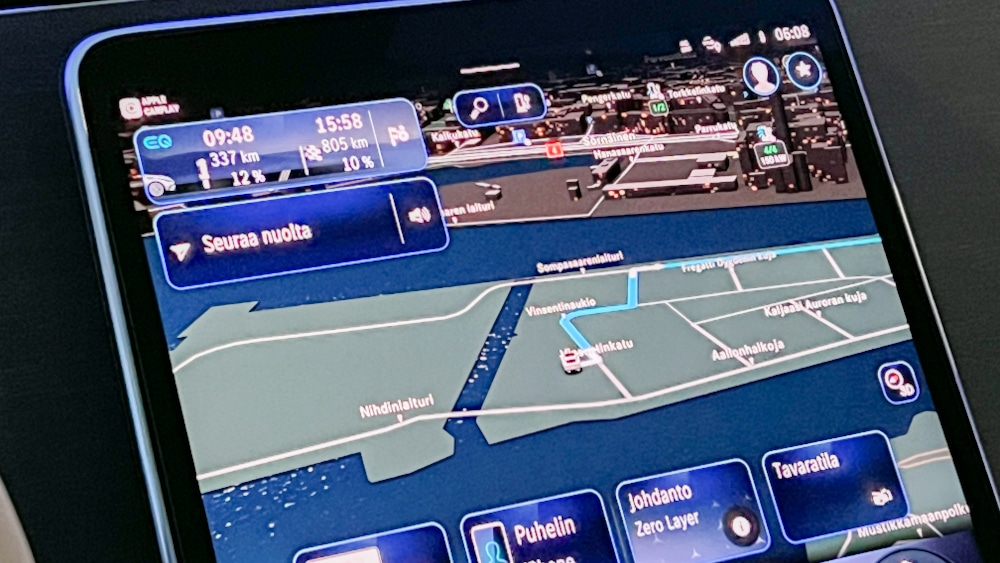
Mercedes offered the EQS 450 model with the longest WLTP range in its all-electric EQ range. The manufacturer claims an operating range of up to 760 kilometres on a single charge for this model.
Mercedes has an excellent range estimation tool on its website which, with the values entered (zero temperature, 50/50 road and motorway driving), calculates the actual range of the car at 449 kilometres. The starting point for the test is therefore a good one, given the comfort offered by the Ace Mercedes.
Start at 6.00 a.m
After breakfast, Google Maps shows a total distance to Kuusamo of just over 800 kilometres and a non-stop driving time of 9 hours and 12 minutes on a quiet Thursday morning.
The rear seats were tipped over in a 40:20:40 ratio, so only the narrow middle seat was tipped over. Otherwise, luggage went quite easily into the 610 litre boot. The boot offers excellent space, especially lengthwise, while height is the first thing to be considered if you want to see out of the rear-view mirror. However, packing is quite effortless, thanks to the large, high opening tailgate.
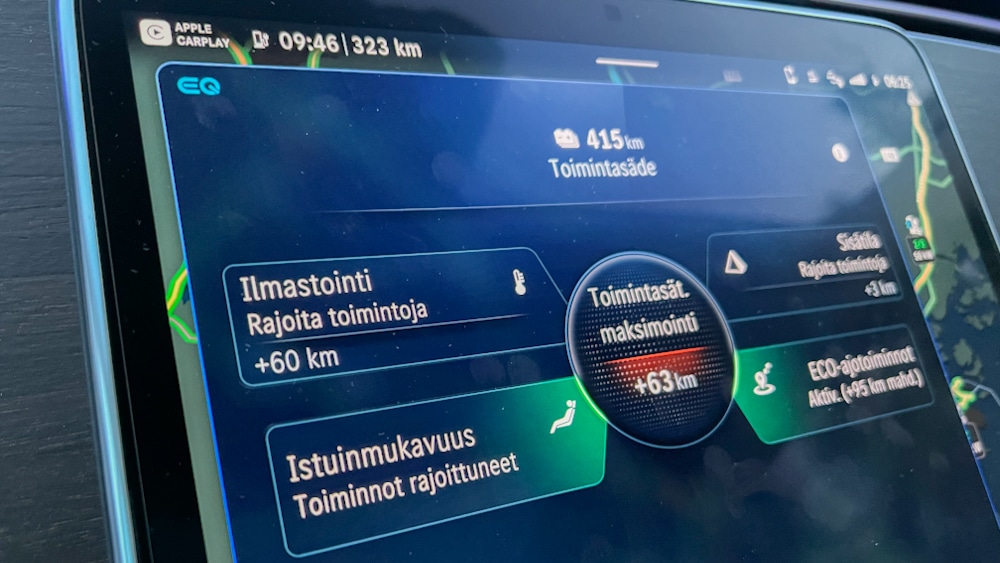
The car left the garage at 6.06 a.m. in the semi-warm garage, without any preheating in the interior, in a slight frost in March. Kuusamo, the car’s navigation destination, suggests that the journey should be completed with two charging breaks, allowing the car to optimise charging speeds and reach the destination as quickly as possible.
According to the navigator, we would arrive at 15.58, giving a total journey time of 9.52 and 10% of the battery remaining at Kuusamo. Compared to Google’s journey time, this would mean that stops for two recharges would only take a total of 40 minutes.
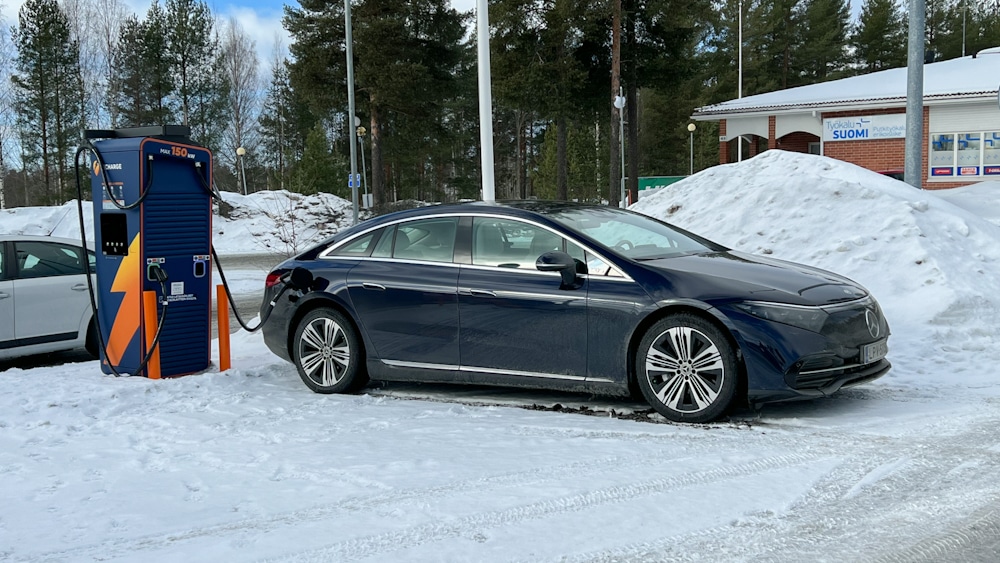
Despite the good and especially fast car proposal, it was decided to stick to the pre-arranged lunch time with another car pool at Neste Lapinlahti (Mati and Liisa’s Station).
The car was immediately praised by the rear passengers for its quietness, seating comfort and the soft ride provided by the air suspension. And it doesn’t feel any worse going forward either. The most striking thing about the EQS, after nearly 2,000 kilometres of test driving, was the effortlessness and quality that was evident and felt in virtually every area – but more on that later.
We quickly grabbed our morning coffee at the Kuort ABC station, but the first and last place to service and recharge the car and passengers was Mati and Liisa’s station at Neste Lapinlahti.
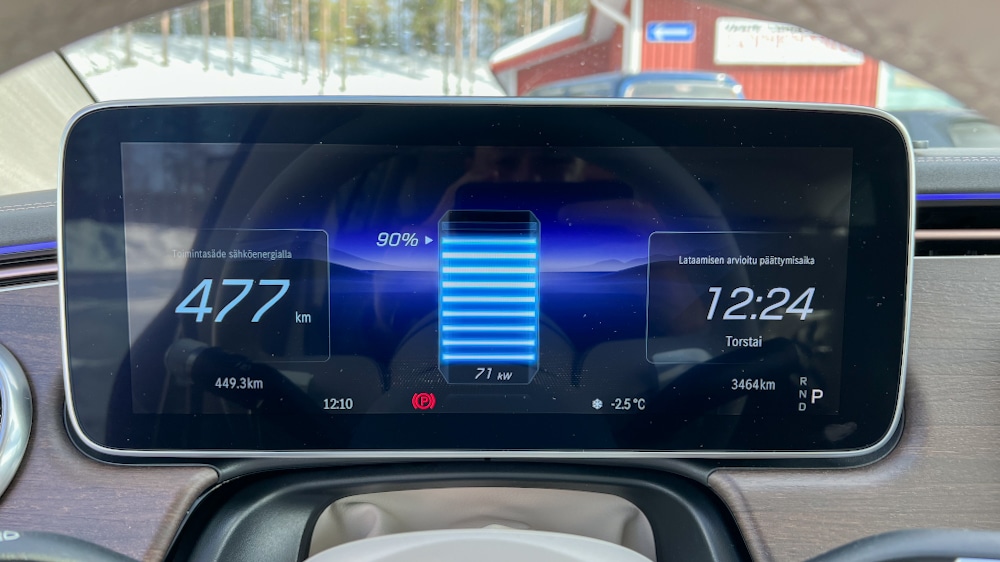
The trip meter reads 449 kilometres as you turn into the yard, and the reserve has dropped from full to eight per cent. According to the car, the battery would still have enough power for 58 kilometres, which in reality would be closer to 40 kilometres. A 150 kilowatt Recharge station with four charging cables is located in the yard.
The EQS charging curve is second to none
The car’s maximum charge rate from the fast charger is “only” 200 kilowatts. At Lapinlahti, the car starts charging at 11.23 a.m. With 8% of the battery and a 150-kilowatt charger, the charging power immediately shoots up to 130 kilowatts, which was good to see, as the intention was to continue the journey without having to wait for the car to charge. The car estimates at this point that a full 100% charge will be achieved by 12.21pm. Time to go and enjoy lunch.
In the middle of lunch, out of curiosity, I have to go and see how the charging is progressing. It was not possible to get the Mercedes me app on my mobile phone into the test car (where I could have monitored the charging performance and progress), so I put on my jacket and head out.
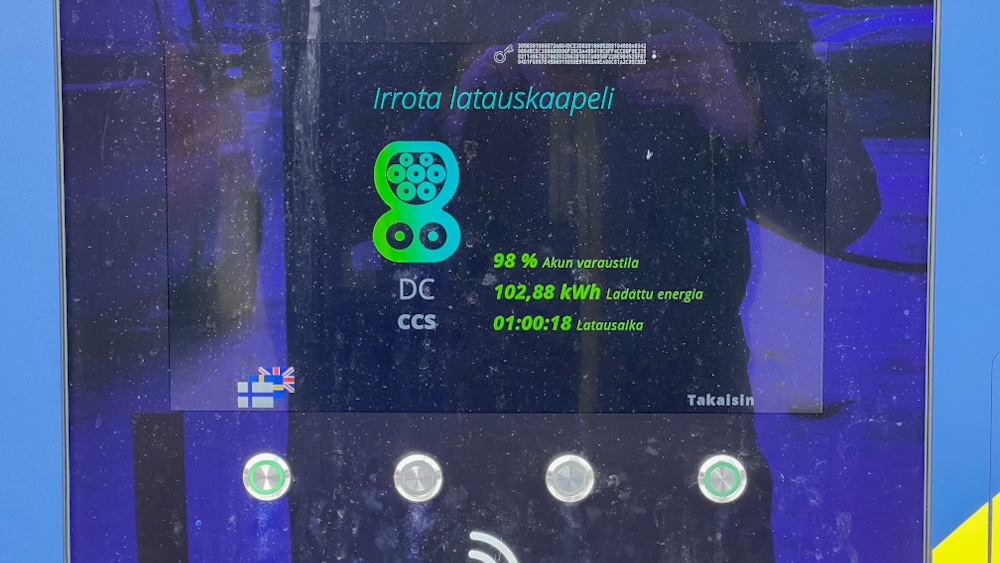
With a battery charge of 52%, the charging power was a commendable 126 kilowatts. The bigger surprise was the charge power at the end, when at 90% charge the car was still charging at a whopping 71 kilowatts and the estimate of full charge had remained almost unchanged with the meter showing only three minutes more than at the start of the charge.
The time estimate for completion of charging was therefore incredibly accurate, which seems to be more and more optimistic for many full electric cars.
Those who have been driving electric cars for more than a few years will have noticed that for many models, the charging performance fades considerably by 60-80% at the latest. The EQS did not seem to suffer from this.

Charging was stopped at 12.23 pm, when the car’s instrument panel read 99% and the charging station showed that 102 kWh had been delivered in one hour and 18 seconds. I have yet to meet another full-electric model that has taken more than 100 kWh on a single charge in one hour. It’s also worth remembering that the charger was only 150 kilowatts and the car’s maximum charge rate is 200 kilowatts from a DC charger.
Heading north again, we arrived in the centre of Kuusamo 10 hours and 35 minutes after leaving Helsinki. The 9 hours and 12 minutes predicted by Google Maps were exceeded by an hour and 23 minutes, of which 10 minutes were spent buying morning coffee in Kuort and a good hour for lunch and charging the car in Lapinlahti. Many thanks to Mati and Liisa for the delicious lunch buffet at Asema!
EQS 450 as a travelling companion
The test car was the rear-wheel drive model of the EQS, with a battery capacity of around 108 kWh. The car is also available in four-wheel drive 450 4MATIC and 580 4MATIC and 53 AMG models.
The four-wheel-drive models have the same battery capacity as the test-driven rear-wheel-drive model, but the four-wheel-drive system results in slightly higher electricity consumption and, comparing WLTP values, the actual range is probably 20-60 km less than the rear-wheel-drive model. The AMG model might have a second hundred kilometres, but that’s probably secondary.
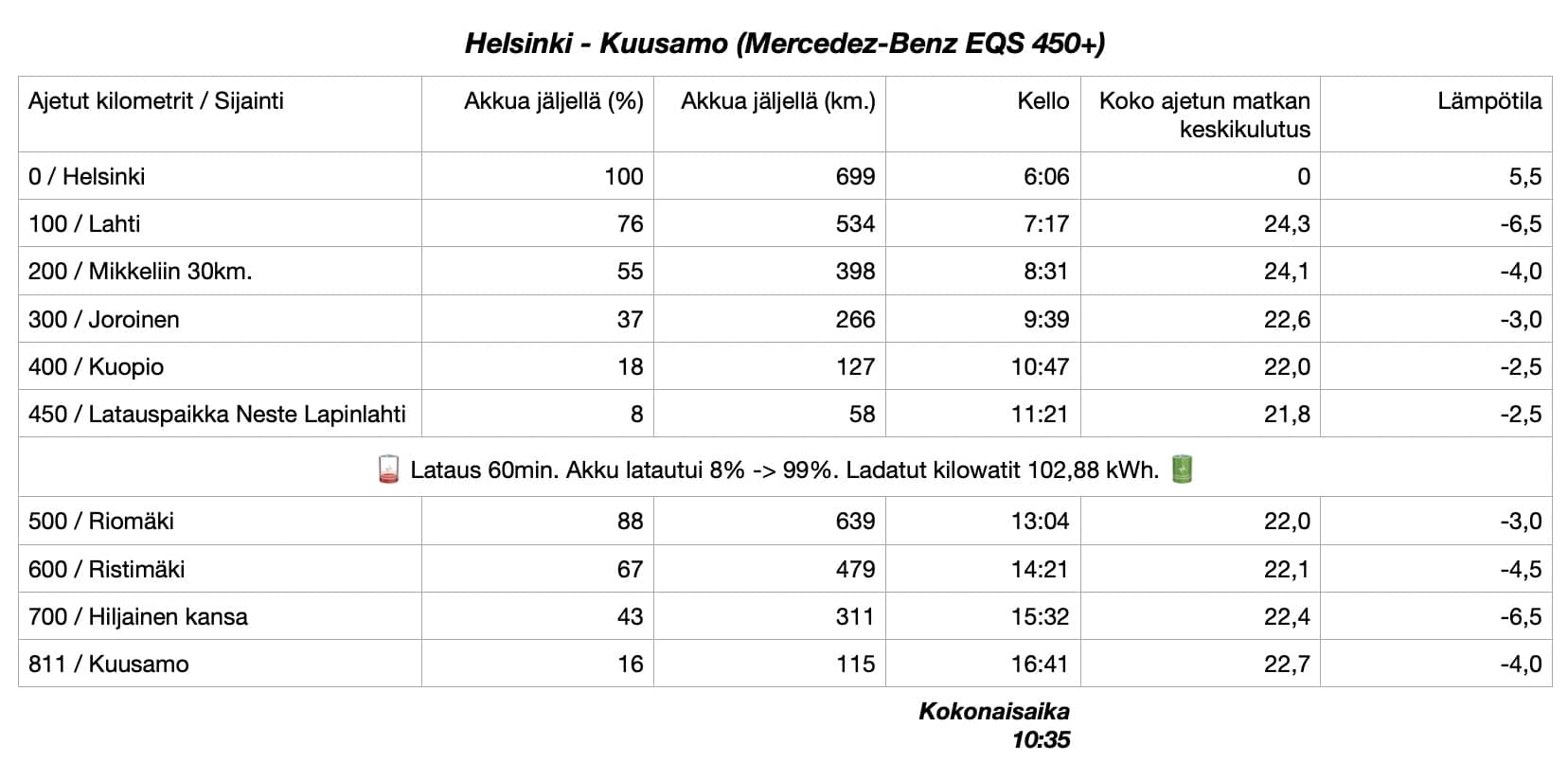
Electricity consumption can be significantly influenced by your own actions and settings. Especially in winter conditions, maintaining the air conditioning and the interior temperature of the car has a major impact on consumption.
EQS has made it easy to maximise the operating range through the EQ menu. Setting the driving mode and air conditioning to ECO mode will, according to the car, save well over a hundred kilometres, at least in winter conditions.
The first stage before charging was largely driven with the air conditioning in ECO mode. The car let the temperature drop to a relatively cool (around 20 degrees), but there was no window fogging, despite the car’s advance warning.
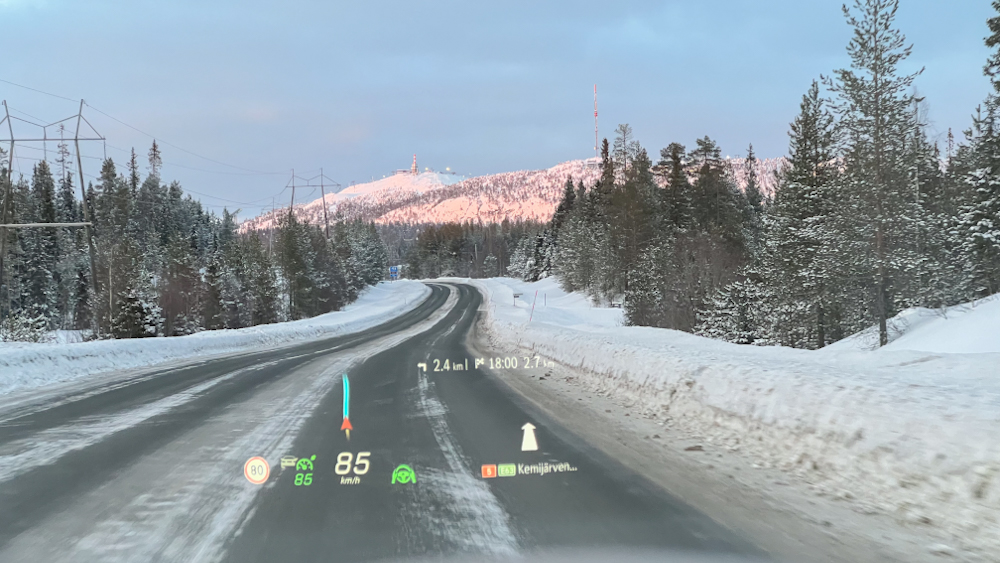
The more unpleasant aspect of driving in ECO mode is that the car’s power output is very limited, which is not desirable in overtaking situations. After the first few overtaking manoeuvres, the car was always switched to Normal mode for the duration of the overtaking manoeuvre, which makes the 2,500-kilo lump move with remarkable grace.
Rear-wheel drive was only noticeable in overtaking situations where the spring sun had melted the slush on the road and in shady spots where the road surface had frozen back into mirror ice. A car of this size and mass would be much quieter in four-wheel drive and there is only a four thousand euro difference in price between the 450 and 450 4MATIC models. The only drawback is that the operating range is slightly reduced in the four-wheel-drive version.

At the same time, though, I have to praise the combination of rear-wheel drive and traction control, which seems to work like a charm. The traction control and traction control don’t let the car and the driver get out of control, even if the momentary loosening of the rear does not feel comfortable at 100 km/h.
On the return journey back south, the EQS enjoyed the standard Digital Light headlights. The headlights are fully adaptive and automatic, so that in the dark the headlights are virtually always on as long-beam headlights and, thanks to the micro-mirror system, the system can automatically isolate a car ahead or oncoming car from the long-beam headlights.
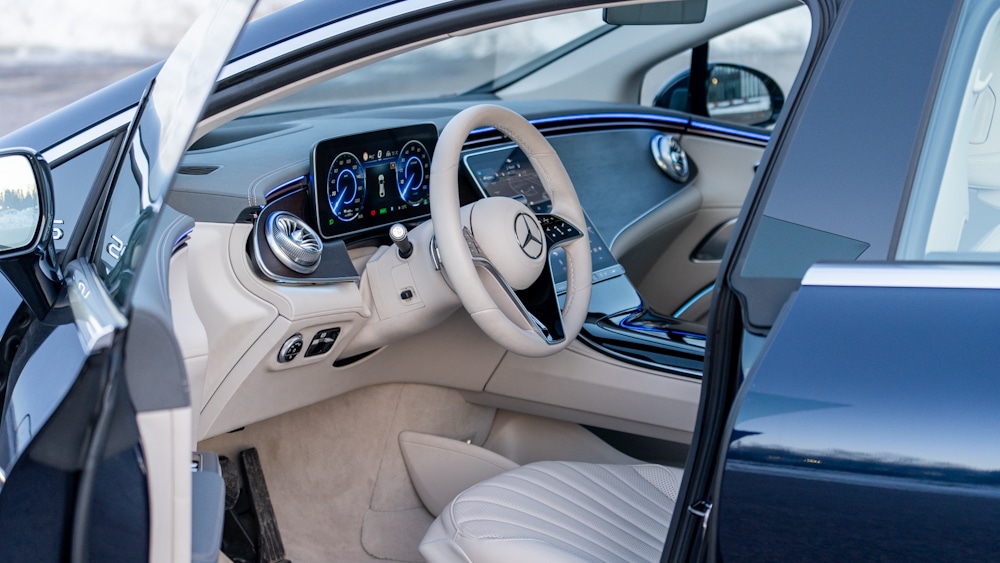
The system can also “draw” different warning patterns on the road, for example of approaching people, traffic signs or, in narrow places on roadworks, the driving width required by the car.
A firework display of standard equipment and technology
The Mercedes EQS is fully loaded with the latest technology and techniques. The car is based on Mercedes’ EVA2 architecture, which is also used in the EQE and their new SUV models. The EQS’s drag coefficient of 0.20 was the best in the world for a production model in July 2021, and to date only a handful of new models have passed it.
The car’s 108 kilowatt-hour, 400-volt battery is Daimler’s own production and comes with a substantial 10-year/250 tkm warranty. The maximum fast charge power of 200 kW is not the highest on the market, but the charging curve when the battery is full is impressive.

In addition, the EQS can be equipped with a 22 kW AC charging option, which is rarely available on a car for the money. This is a great help for slower AC charging, for example in shopping centres, where you can get around 100 kilometres of extra battery power per hour.
On models sold in Japan, the car already offers two-way charging, which allows the car’s battery charge to be tapped to power a variety of electrical devices. This could also be of great benefit in Finland’s cabin and forest conditions.
Four-wheel steering with 4.5 degrees of rear wheel rotation comes standard on the car, allowing the 5.2-metre ace to nimbly manoeuvre in tighter spaces.
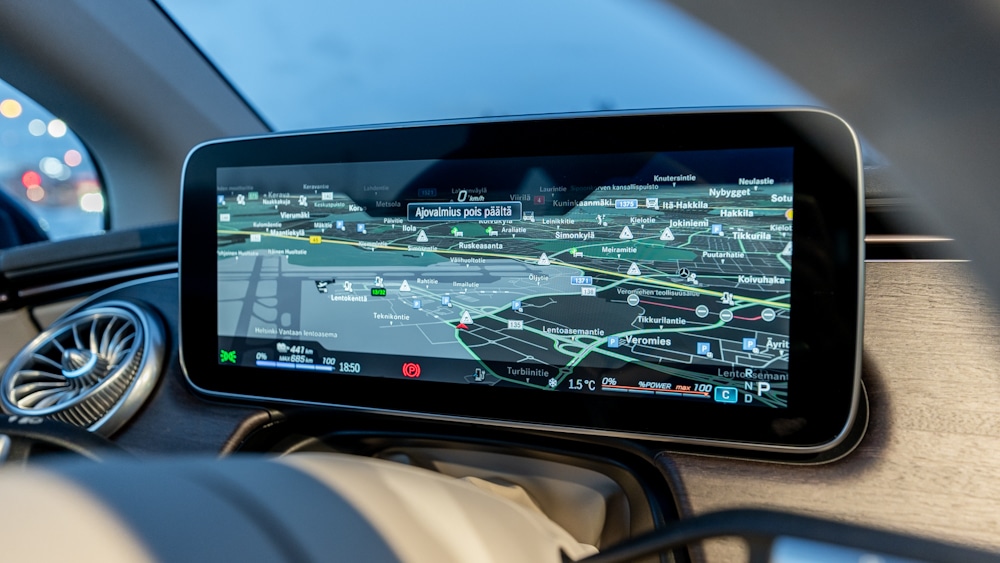
An optional four-wheel steering system that turns the rear wheels as much as 10 degrees is available. The standard air suspension tackles the sharpest bumps on city streets and ensures a smooth ride on the pump for touring.
The only thing that got a little distracting in the 140-tonne car was the visually dated MBUX infotainment system. The functions were clearly informative and easy to get to grips with. In terms of graphics, especially the navigation screen, there is still room for improvement in a car of this level.

The option list includes a huge MBUX Hyperscreen, which stretches across the entire dashboard from A-pillar to A-pillar and is visually like a single screen.
The Hyperscreen consists of three screens, so in addition to the instrument cluster and the instrument cluster, there is a third screen for the co-driver. In terms of functionality and visual appearance, the Hyperscreen, despite its name, appeared to be on a par with the standard ‘basic’ screen that comes as standard, based on a quick look around.
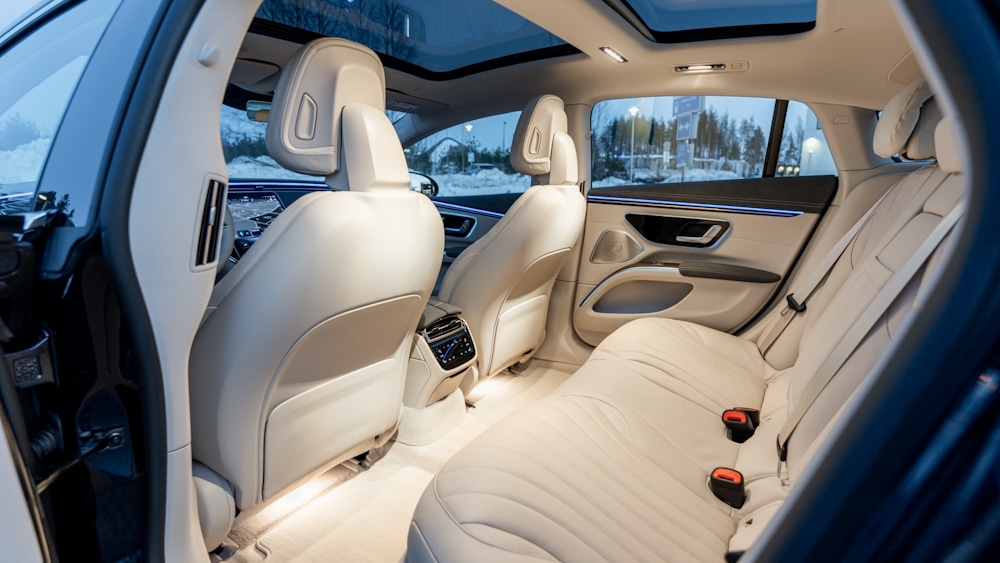
For those who appreciate clean air, the optional list also includes Energizing Air Control Plus with HEPA filter, which filters out more than 99.65% of particles of all sizes, and 600 grams of activated carbon to neutralise odours.
Effortlessness, vibrancy and vision
The test drive in Kuusamo showed that electric car travel has become an effortless way to get around Finland, including between the north and south, thanks to the explosion of charging stations in recent years.
Admittedly, the EQS is certainly one of the most effortless tools for this kind of travelling on the market today, but the EQS well proves that, at least in this case, there is no need to wait for a full electric car to charge, but the car even has to wait for passengers.

In terms of costs, the drive from Helsinki to Kuusamo was not optimal, as the Recharge station in Lapinlahti charged as much as 63 cents/kWh. Once in Kuusamo, the price per kilowatt was just over 30 cents, so the total cost for the outward journey was €96.12 – just under €12 per 100 kilometres. Using cheaper fast chargers, the trip could have been done for around €60.
The ski trip to Kuusamo and the total distance of 1700 kilometres was covered with the EQS with amazing ease thanks to the outstanding driving and travelling comfort. Despite its coupe-like design, the car pulled at least commendably, there was plenty of interior space in the front and rear, and the low noise level and good exterior and interior lighting kept the driver alert.

The EQS is a brilliant showcase of Mercedes’ (all-electric) car-making skills and the brand aims to offer consumers a fully carbon-neutral new car range by the end of the next decade as part of its Ambition 2039 programme. As the latest all-electric models, Mercedes will offer the EQE and EQS higher SUV models, with the larger EQS SUV offering space for up to seven people.

Mercedes-Benz EQS 450
- Electric motor power: 245 kW. (333 hp.)
- Electric motor torque: 568 Nm.
- Acceleration: 6.2 sec. (0-100 km/h)
- Driving battery capacity (net): 108.4 kWh.
- Manufacturer’s declared combined fuel consumption: 16.9 kWh/100km.
- Manufacturer’s declared range (combined): 760 km (WLTP)
- Consumption during test drive: 22.7 kWh/100km (Helsinki-Kuusamo)
- Test-driven range on a single charge: 480 km (-4 ⁰C)
- Maximum charging power (DC): 200 kW.
- Maximum charging power (AC): 11 kW. (optional 22 kW.)
- Tare weight: 2480 kg.
- Cargo space: 610 l.
- Traction: rear-wheel drive
- Towing capacity: 750 kg.
- Starting price: 124 050 euro
- Price for test drive: €138 100
